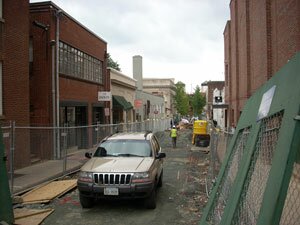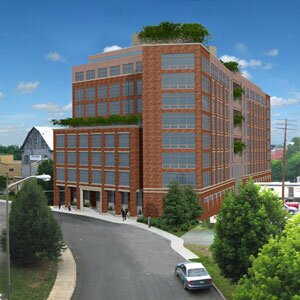ONARCHITECTURE- Third street blues: What's up with big dig, Croxton's green giant?

The Third Street Dig: when it will ever end?
PHOTO BY HAWES SPENCER
Before the Third street streetscaping project on the Downtown Mall commenced four months ago, Shirley Barrett, who owns a nail shop there, had already endured the Paramount renovation and the burying of overhead utilities, a project that blocked the side street for more than a year. While she understands that this kind of work takes time, she's "grown tired" of waiting for it to be finished.
"They sent a letter in August that said it would be finished in September," she says, looking skeptical. "But now they say it won't be finished until mid-November."
Barrett is referring to the $805,749 replacement of water and sewer lines beneath the street, a project whose original cost had been projected to be $397,180. In fact, an early bid on the project last April was rejected because it was too high at $765,000– double the city engineer's estimate, according to construction reports.
According to City Engineer Tony Edwards, the overhead utilities– electric, cable, telephone– buried during the Paramount renovation have complicated the replacement of water and sewer lines.
"There are a lot of services being installed underground there, and it's become more complicated than we thought it would be," he says.
Indeed, while Edwards says the City is "shooting" for a November 19 completion, he admits that bad weather and other circumstances may push that date forward. Complicating predictions are plans to re-brick the street after the current work is finished.
Meanwhile, for merchants like Barrett and businesses like the Fleurie and Rapture restaurants, the delays only frustrate their customers and disrupt their operations. Managers at Rapture say they can't take deliveries on the street, and when patrons exit Fleurie, one of Charlottesville's most exclusive and expensive restaurants, they're greeted by a large yellow port-a-potty. Because of the construction and fencing, Barrett says, her elderly customers have stopped coming, and now that the street is deserted in the early morning and evenings, she worries about her safety while opening and closing her shop.
Still, Barrett says City staff has been sensitive to the problems they've caused for her and others on the street, and she understands the complexities of the project.
"I'm not trying to push them," she says diplomatically, "but I'm ready for this to be finished."
Return of the Green Monster
When we spoke earlier in the fall to City planner Brian Haluska about the so called "Green Monster," a proposed nine-story luxury green condominium building at 201 Avon, it looked like the developers had abandoned the project.
"We haven't heard back from the architect or the developer yet," Haluska said then about the project slated to go between the barn-like headquarters of Beck-Cohen heating and air-conditioning and the CSX railroad tracks below the Belmont bridge, and which was to be designed by New York-based green architecture pioneer Randy Croxton. "If we don't hear from them by October 10, their site plan approval will expire."
Haluska said it was rare that a developer would wait that long to submit a formal site plan, and that it usually meant the project wasn't going to happen. "Sometimes they can't get the financing, or have some other problem," he said, "and they simply let the approval expire."
However, on October 10, expiration day, Croxton finally handed in a plan. Designed to achieve a platinum rating under guidelines dictated by the Leadership in Energy and Environmental Design (LEED) green building rating system, it will represent a standard very few buildings in the country can meet. The tower will be made of environmentally friendly materials, a green roof and gardens will grace the upper terraces, and a rainwater collection system will provide water for irrigation and flushing toilets.
The project was approved by a close 4-3 vote of the Charlottesville Board of Architectural Review last December. Clearly, some BAR members were alarmed by the sheer mass of the building, which will rise steeply beside the Belmont Bridge and dwarf the new Transit Center and music pavilion.
"It's a difficult design problem for us," said BAR vice-chair Syd Knight, who voted against the project. "It's the first truly large building for that area, and some of us felt it would dwarf everything around it."
In particular, Knight and others were concerned that if similar vertical growth did not happen in that area (although current and proposed plans– such as Coran Capshaw's coal Tower project– suggest it will happen) it could stand to lose its contextual relationship with the neighborhood.
Not to put too fine a point upon it: it might stand out like a big green sore thumb.
"That prospect gave us all pause," said Knight.
As we wondered last year: will people be willing to pay $200-$350 a square foot for a high-rise condo on an industrial site abutting the railroad tracks near the amphitheater?
Of course, as Haluska points out, even if the final-hour site plan is approved, there's still no guarantee the project will ever happen.
"The larger the building, the more variables involved in the planning and construction of the project," he says. "Consequently, there are more opportunities for something to hold up or stop the project."
Indeed, as Haluska pointed out the last time we spoke, a developer has three years after a building permit is issued to follow through on a project– a permit has not yet been issued for 201 Avon– and developers typically need to have 30 percent of their condos sold before a bank will approve a construction loan.
"We don't have any knowledge of the financing details," says Haluska. "That's not something the government reviews."

Architects designing the big "Green Monster" alongside the Belmont Bridge submitted their site plan on deadline day.
PHOTO COURTESY CROXTON COLLABORATIVE
#